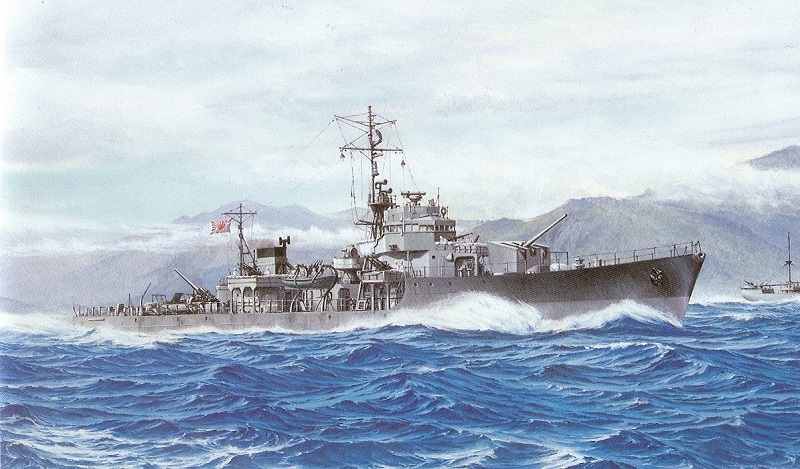KAIBOKAN!


© 2006-2009 Bob Hackett, Sander Kingsepp and Peter Cundall
9 February 1945:
Launched and named SHIGA.
20 March 1945:
Completed and assigned to the Kure Naval District. Cdr Nai Mitsuru is the Commanding Officer. Attached to the Kure Guard Unit for workup and training. Engages in an anti-submarine exercise in the Bungo Straits.
6 April 1945:Operation
TEN-ICHI-GO - The Attack on American Invasion Forces at Okinawa:
Two
Nakajima A6M2-N Nakajima A6M2-N
"Rufe" float planes and six auxiliary submarine chasers are dispatched to search the Bungo Straits area. That afternoon, SHIGA and kaibokan CD-194, are dispatched to conduct an ASW sweep south of the Bungo Straits. [1]
At 1520, battleship YAMATO departs Tokuyama escorted by DesDiv 43’s HANAZUKI, KAYA and MAKI as far as the Bungo Straits where the destroyers detach for port. Vice Admiral (Admiral, posthumously) Ito Seiichi (former CO of HARUNA)(39), CINC, Second Fleet, leads his Surface Special Attack Force’s YAMATO southward towards Okinawa with DesRon 2's light cruiser YAHAGI, DesDiv 17's ISOKAZE, HAMAKAZE and YUKIKAZE, DesDiv 21's KASUMI, HATSUSHIMO and ASASHIMO, DesDiv 41's FUYUZUKI and SUZUTSUKI.
10 miles S of Fukashima Island, Bungo Straits, Kyushu. Alerted by an “Ultra” code-breaker’s signal from Pearl to a possible sortie by YAMATO, Cdr John J. Foote’s USS THREADFIN (SS-410) is maintaining station at periscope depth in the channel. In mid-afternoon, Foote spots what appears to be two UKURU class escorts heading toward him. Suddenly, a Rufe floatplane appears overhead. Foote takes THREADFIN down to 100 feet. When he next raises his ‘scope, Foote spots seven more Rufes searching very low overhead.
30 miles S of Fukashima Island. LtCdr Frederick E. Janney’s new USS HACKLEBACK (SS-295) is also on station searching the eastern approaches to the Bungo Straits for the YAMATO group.
At 1830, the Attack Force negotiates the Straits’ western channel at 22 knots when a patrol plane radios YAMATO that it sighted an enemy submarine ten miles from Tsukudajima. In cooperation with an Aichi E13A1 Type 0 “Jake” reconnaissance floatplane, SHIGA makes sonar contact with what she takes to be a submarine 2,800 yards ahead. She attacks the contact twice, expending all of her depth-charges, after which the contact is lost. Her lookouts sight bubbles of air and a minor oil slick on the surface. SHIGA’s CO claims sinking the "submarine".
THREADFIN’s crew hears the distant depth-charging and wonders if HACKLEBACK is under attack. Aboard HACKLEBACK, Janney’s crew also hears the depth-charges and wonders if THREADFIN is under attack.
The Attack Force changes course to 140 degrees and assumes an anti-submarine formation. To avoid a submarine in the Hyuga-nada, the force changes to a westerly course. The escorting destroyers move ahead and the whole group begins zigzagging. A lookout on ISOKAZE spots THREADFIN on the surface. At 2100, the Attack Force swings to the south to avoid a possible torpedo attack. At 2144, THREADFIN radios a detailed sighting report of the Attack Force's presence in the Bungo Straits to COMSUBPAC at Guam.
12 April 1945:
Arrives at Maizuru.
22 April 1945:
Nanao Bay. SHIGA resumes training.
13 May 1945:
Reassigned to the 21st Coast Defense Group.
15 August 1945: Cessation of Hostilities:
Tsushima Straits. While on patrol, SHIGA’s crew is notified of the termination of the war.
30 November 1945:
Removed from the Navy List.
1 December 1945:
Assigned to mine sweeping duties by the Allied
Occupation Forces.
1 August 1946:
Reassigned as a special cargo ship by the Allied
Occupation Forces.
1 November 1946:
Reassigned as a ferry for the US military between Hakata
and Pusan, Korea..
31 December 1947:
Discontinues ferry duties. Transferred to the Japanese
Department of Transportation.
1 November 1948:
Yokohama. Remodeled at Mitsubishi Heavy Industries, Ltd.
shipyard.
1 January 1949:
Reassigned to the Japanese Maritime Safety Agency.
Functions as a training ship and renamed KOJIMA.
31 December 1950:
Reassigned as a Central Meteorological Observatory
ocean station vessel in the Ministry of Transport and renamed SHIGA MARU.
1 January 1954:
Reassigned to the Japanese Maritime Safety Agency.
Functions as the Marine Preservation University’s school ship and renamed KOJIMA (PL 106).
6 May 1964:
Discarded by the Maritime Safety Agency. Later, undergoes
repairs.
31 August 1965:
SHIGA’s hull is used as a pavilion of a maritime
amusement park in Chiba City.
1998:
The deteriorating hull is dismantled and scrapped.
Thanks for assistance go to Dr. Higuchi Tatsuhiro of Japan.
-Bob Hackett, Sander Kingsepp and Peter Cundall

